
George was born in Dorking in December 1892 to Charles and Sarah Way (who went on to have six daughters and two other sons). He was baptised a couple of months later on 10th February 1893 in St. Martins Church.
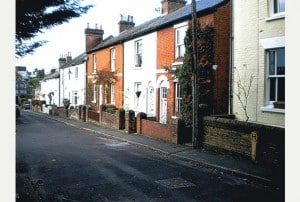
From the 1901 census, we can see that George was living with his mother, father, three sisters, two brothers and a lodger in Orchard Road, the road that Valentine Strudwick, one of the youngest men to die in WW1 at 15 years of age, also lived in, making it possible that they knew each other in their childhoods.
The 1911 census shows the family to have moved south to 4 Beare Green Cottages in Capel, and at 18 years old, George is listed as a wagoner on a farm.
George enlisted to the 5th Battalion of the Queen’s Regiment of the Territorial Army in Holmwood the week he turned 17 (on the 7th December 1909), and began military training (at the Duke of York’s Royal Military School, Royal Hibernian Military School, Queen Victoria School), gaining a 3rd Class Certificate on 20th March 1913. Enlisting to the 1st Battalion Leicestershire Regiment at Guildford on the 17th May 1911, he continued his training, and was promoted to Lance Corporal on the 27th March 1914. This rank was usually appointed after 12 years’ service as a regular private, but in lieu of the approaching war, it was common for the army to appoint the rank more frequently to less experienced soldiers. His service number was 9198, which corresponds to the date he enlisted.
As part of the 1st Battalion, George Way would have served in the Western European Theatre, disembarking for France on 9th September 1914, arriving in St. Nazaire on the 10th. Prior to this, the battalion had been stationed in Femoy, Ireland. During George’s short war, he would have engaged in the battle at Fosse Marguel, and the First Battle of Ypres, marching to Rue du Bois, then Armentieres, Bois Grenier on 19th October.
They spent the first months holding this line under terrible conditions and suffering their first casualties, and it was between the 19th October and the 22nd November that the first Salient was created. Ypres remained in possession of the allies throughout the war and became an important symbol for gallantry and sacrifice. George was killed in action protecting this line on 14th November 1914.
George Way is commemorated on the Ploegstreert Memorial in Belgium. This memorial is for the 11,000 men who have no known grave, owing to them being killed in action in the minor everyday battles during the shifting front lines of the war.
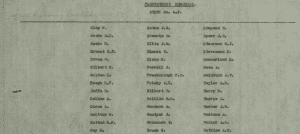
We have the documents that show how George was to be commemorated, shown to be completed on the 10th December 1927.
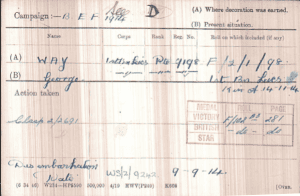
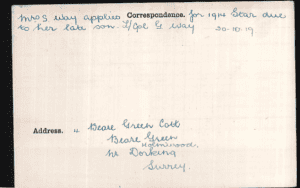
During his service, George would have received the 1914 Star, the British Medal, and the Victory Medal, issued to all soldiers who served in a theatre of war before November 23rd 1914. We can see from his medal cards that his mother received the medals after the war in 1919.
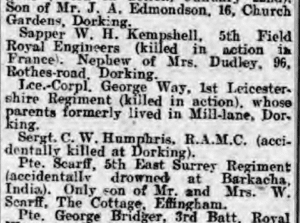
George’s service was commemorated in several newspapers during the war owing to the short length of his period of service. His name is included in the Roll of Honour on the 28th December 1915 in the Reigate Surrey Mirror, and again on the 31st December.
Military records which document George’s time in the army, and many correspondences between the War Office and his mother, Sarah, to receive the necessary documents after his death.
Charles Way, George’s father, is dead (having died in October 1915), and there is just one of his brothers, Harry Way living in Beare Green with his mother. His other brother, Peter, is in the 7th battalion Gloucester’s in Bombay India, and his sisters moved around England.
| Born | Dorking | |
| Lived | Dorking | |
| Son of | Charles and Sarah Way | |
| Regiment | 1st Battalion, Leicestershire Regiment | |
| Number | 9198 | |
| Date Overseas | 9th September 1914 | |
| Date of Death | 14th November 1914 | |
| Place of Death | Flanders | |
| Cause of Death | Killed in Action | |
| Age | 21 | |
| Memorial | Ploegsteert Memorial, Belgium |

